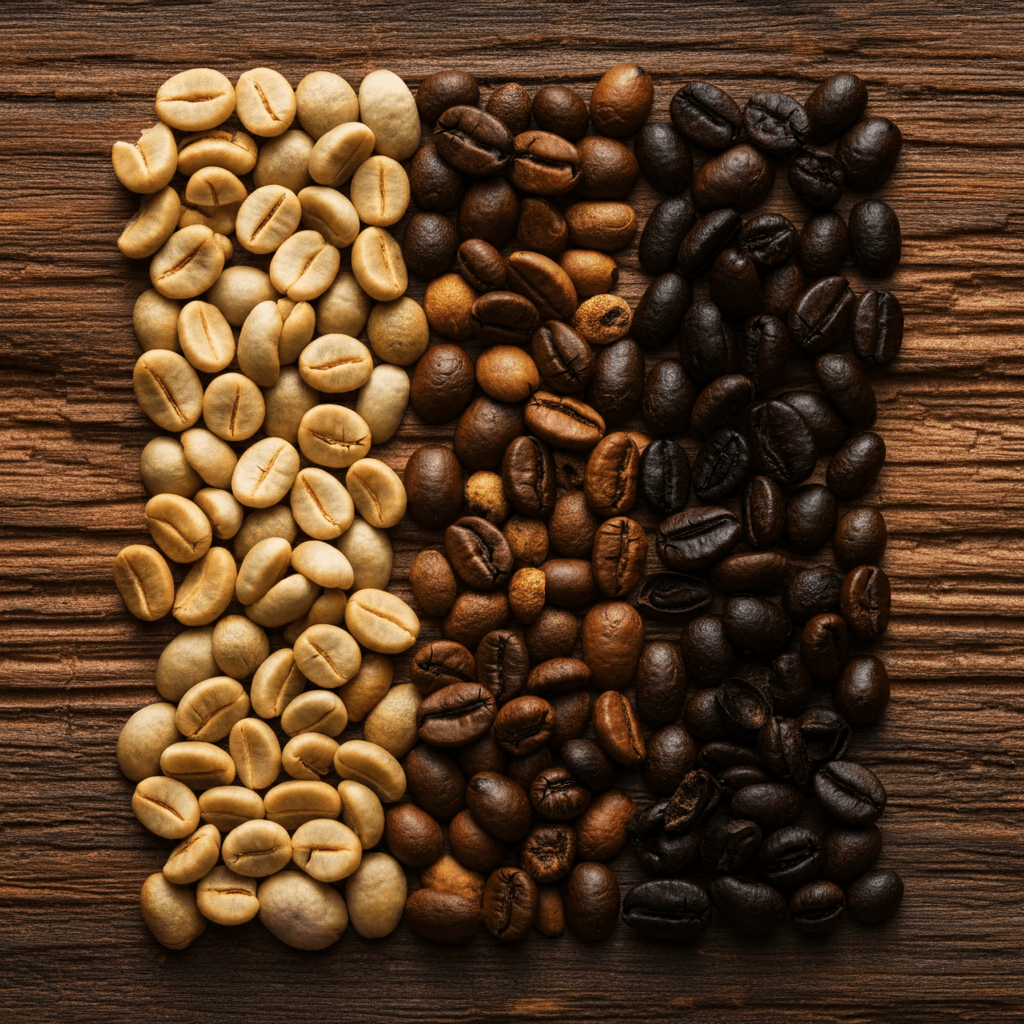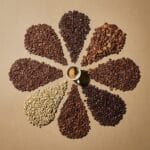Welcome back, coffee explorers! You’ve ventured through the diverse landscapes of coffee origins and unraveled the mysteries of terroir and climate. Now, prepare to embark on a new adventure as we delve into the transformative world of coffee roasting. Discover how the alchemy of heat and time can unlock a spectrum of flavors hidden within each bean, shaping your coffee experience with every degree of change.
The Roasting Journey: From Green to Brown
Before we explore the nuances of light, medium, and dark roasts, let’s take a quick look at the roasting process itself:
- The Starting Point: Coffee roasting begins with green coffee beans, which have a grassy aroma and very little flavor. Think of these as raw ingredients waiting to be transformed.
- The Yellowing Stage: As the beans heat up, they start to turn yellow and emit a grassy smell. This is where the initial drying and chemical changes begin.
- The First Crack: Around 385°F (196°C), the beans make a cracking sound, similar to popcorn popping. This signifies that the beans are starting to expand and release moisture.
- The Second Crack: If roasting continues, the beans will reach around 435°F (224°C) and undergo a second crack. This indicates further breakdown of sugars and the development of oils.
- The Cooling Process: Once the desired roast level is achieved, the beans are immediately cooled to stop the roasting process. This preserves the intended flavor profile and prevents over-roasting.
Light Roasts: Bright, Acidic, and Complex
Light roasts are coffee’s equivalent of a lightly seared steak – they highlight the bean’s original flavors and characteristics. Roasted just after the first crack, these beans are light brown in color and have a dry surface.
Flavor Profile:
- Higher acidity: Light roasts tend to have a more pronounced acidity, which can be perceived as a bright, tangy, or fruity quality.
- Pronounced brightness: This refers to a lively, vibrant quality in the coffee’s flavor, often associated with floral or fruity notes.
- Complex, fruity, or floral notes: Light roasts often showcase the unique flavors inherent to the coffee bean, such as berry, citrus, or floral aromas.
- Light body: The body describes the coffee’s mouthfeel, and light roasts typically have a lighter, tea-like body.
- No oil on the bean surface: Since light roasts are roasted for a shorter time, they don’t develop oils on the surface of the beans.
Medium Roasts: Balanced, Sweet, and Smooth
If light roasts are like rare steak, medium roasts are the perfect medium-rare – balanced, flavorful, and crowd-pleasing. These beans are roasted after the first crack but before the second, resulting in a medium brown color and a slightly sweeter taste.
Flavor Profile:
- Balanced acidity and sweetness: Medium roasts offer a harmonious balance between acidity and sweetness, resulting in a well-rounded flavor.
- Medium body: The body is more substantial than light roasts but not as heavy as dark roasts.
- Smooth, rounded flavor: Medium roasts tend to have a smoother, more mellow flavor profile compared to light roasts.
- Notes of chocolate, nuts, or caramel: As the beans roast longer, they develop sweeter notes, such as chocolate, nuts, or caramel.
- Little to no oil on the bean surface: Medium roasts may have a slight sheen but generally don’t exhibit significant oil on the surface.
Dark Roasts: Bold, Bitter, and Intense
Dark roasts are the well-done steaks of the coffee world – bold, intense, and sometimes controversial. Roasted until the second crack or beyond, these beans are dark brown, oily, and have a pronounced bitterness.
Flavor Profile:
- Low acidity: The extended roasting time reduces the acidity, resulting in a less tangy or bright flavor.
- Pronounced bitterness: Dark roasts often have a noticeable bitterness, which can be perceived as a smoky, roasted, or even burnt quality.
- Bold, robust flavor: The flavor is intense and full-bodied, often masking the subtle nuances of the coffee’s origin.
- Notes of dark chocolate, toasted nuts, or burnt caramel: The sweetness shifts towards darker, more intense notes, like dark chocolate or burnt caramel.
- Full body: Dark roasts have a heavy, syrupy body, coating the mouth.
- Oily bean surface: The oils within the bean migrate to the surface during the extended roasting process.
Discovering Your Perfect Roast
Just like with steak doneness, the “best” roast level is a matter of personal taste. There’s no single “perfect” roast—it all depends on your individual preferences and how you enjoy your coffee.
To discover your ideal roast, consider these questions:
- Do you crave the vibrant acidity and nuanced flavors of a light roast?
- Do you prefer the balanced sweetness and versatility of a medium roast?
- Or do you gravitate towards the bold, intense flavors of a dark roast?
The best way to find your roast sweet spot is through exploration and experimentation. Try a variety of roasts, from light to dark, and pay attention to the flavors and aromas that you enjoy most. Remember, the journey of coffee exploration is an ongoing adventure. Your preferences may evolve over time, so don’t be afraid to revisit different roast levels and rediscover new favorites.
Beyond the Roast: A Glimpse into Other Flavor Factors
While roast level plays a significant role in a coffee’s flavor, it’s just one piece of the puzzle. Other factors, such as bean origin, processing method, and brewing technique, also contribute to the final taste. We’ll explore these factors in more detail throughout the “Untold Coffee Brewing Knowledge Series.”
The Journey Continues: Mastering the Art of Roasting
Now that you’ve explored the flavor spectrum of light, medium, and dark roasts, you’re ready to delve deeper into the art and science of coffee roasting. In our next article, “Bloom 202: II. The Art and Science of Coffee Roasting” we’ll uncover how roasters manipulate time, temperature, and airflow to create unique flavor profiles and explore the fascinating chemical transformations that occur during the roasting process.
So, keep your taste buds primed and your curiosity roasted – the art and science of coffee roasting await! Get ready to uncover the secrets behind crafting the perfect roast as we continue our journey through the fascinating world of coffee.





No Comment! Be the first one.